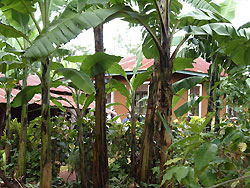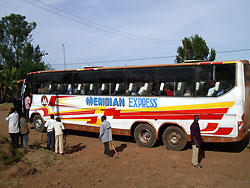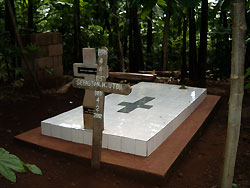| Period: 8 December 2005 - 2 April 2006. Country: Tanzania |
|
(1) The Process of Formation of Urban-Rural Relationships: History and Current Aspects in the Case of the Chagga in Tanzania |
| MIZOUCHI Yoshiyuki (Division of African Area Studies) |
| Key Words: Tanzania, Chagga, Urban-Rural Relationship, Burial Rite, Urban Association |
 |
| Home garden: Bananas and coffee are grown in the area surroundings the house. |
 |
|
A bus connecting urban and rural areas. Urban dwellers return home on various occasions. |
|
 |
| A grave in a home garden. |
(2) The Chagga people inhabit the hillsides of Mt. Kilimanjaro in northern Tanzania, and cultivate coffee and banana as their main crops. Some Chagga people migrated to urban areas a long time ago and some work as merchants and highly educated elites. People living in the urban areas maintain relationships with their home villages. They maintain land and build houses there. Moreover, they return home on various occasions, and are buried on their own lands.
This study aims to clarify the historical process of how urban-rural relationships were built, and how they are maintained at present, by conducting research in both rural and urban areas focusing on the socio-economic and political changes that have taken place in Tanzania. Researches conducted in rural areas have aimed to clarify the process of historical change in livelihoods, including migration to urban areas. I have also aimed to grasp the current circumstances of rural areas, in which the land held by each household is becoming smaller and smaller as a result of: (1) rapid population growth, and (2) land inheritance practices in which the father’s land is usually distributed equally among his sons. The collapse of the coffee industry, which was the main source of livelihood, has also affected the rural population. My research focuses on the changes in the social relationships between village and urban dwellers, with special reference to the latter’s support for the rural population. In urban areas, some Chagga have organized associations for returning bodies to home villages for burial when people die in urban areas. These associations also have a role in organizing Chagga urban dwellers. This study clarifies these activities and its influence on rural-urban relationships.
(3)
Dec. 9 to 23, 2005. Literature review in Dar es Salaam
Dec. 13, 2005. Workshop seminar and discussion with Tanzanian researchers
Dec. 24, 2005 to April 2, 2006. Field research in Makiidi village, Rombo district, Kilimanjaro region
- Grasping the recent socio-economic situation in Makiidi village
From the interviews conducted with landowners and inhabitants, the following points were clarified: (1) Many households have stopped or temporarily halted the production of coffee and tried to find other income sources such as business activities including selling farm products in the market. (2) Many people living in urban areas are contributing to economic life in the village in forms such as remittances to their relatives, assistance for village matters, lending their land in the village, and securing job opportunities for young people currently living in the rural areas. I also observed a new phenomenon under which married and unmarried women who have economic bases in urban areas make remittances to their relatives living in rural areas.
- Clarifying historical changes in the migration pattern
For each household I collected records on historical changes in the places of residence of household members. My research clarified the fact that migrations in the past between the village and urban areas were only conducted by men, and that the periods of stay in the urban areas were short. However, the recent trend turned out to involve more people moving to urban areas regardless of sex, along with a lengthening of the period of stay in urban areas. This change may have a major influence on land management and the maintenance of relationships among lineage members.
- Collection of data and observations related to burials
My research on burial places revealed that in the past, many people returned to their village after retirement and were buried there. Those who died in urban areas were buried there, and some stones and soil from the graveyard were sent to the home village for “burial.” However after the 1990s, many associations were set up in urban areas and the bodies are now sent home to the villages. These associations are currently involved in political and economic activities as well.
|